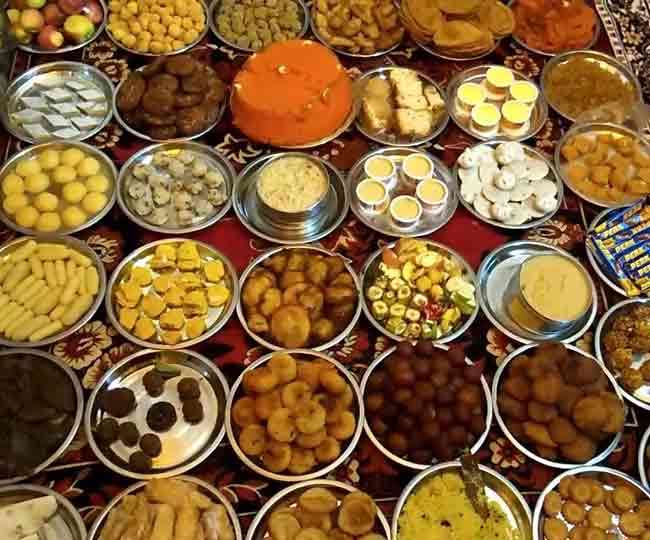
Ganesh Chaturthi Bhog: A Divine Feast of 21 Traditional Maharashtrian Delicacies to Seek Lord Ganesha's Blessings
Introduction:
Ganesh Chaturthi, also known as Vinayaka Chaturthi, is a vibrant and beloved Hindu festival celebrated with great enthusiasm across India, with Maharashtra being one of its most significant hubs. This auspicious occasion marks the birth of Lord Ganesha, the revered elephant-headed God of wisdom and prosperity. One of the key rituals during this festival is the offering of Bhog (food offerings) to Lord Ganesha. In this detailed blog post, we will explore the rich and diverse tradition of 21 types of Bhog offered during Ganesh Chaturthi in the authentic Maharashtrian style. These offerings, which include fruits, dry fruits, Charnamrit, Panchamrit, and Paan where applicable, are prepared with devotion and are meant to seek the blessings of Lord Ganesha.
The Significance of Bhog during Ganesh Chaturthi:
Bhog during Ganesh Chaturthi is a way for devotees to express their love, devotion, and gratitude towards Lord Ganesha. It is believed that offering these delectable dishes to the deity not only pleases Him but also invokes His blessings for wisdom, prosperity, and the removal of obstacles. Bhog during this festival is a way of celebrating Lord Ganesha's presence in our lives and acknowledging His divine grace.
Now, let's embark on a gastronomic journey through the 21 types of Bhog offered during Ganesh Chaturthi in the traditional Maharashtrian style:
1. Modak: These sweet, steamed or fried dumplings filled with coconut, jaggery, and cardamom are Lord Ganesha's favorite and symbolize His love for sweets.
2. Ukadiche Modak: A variant of Modak, these steamed rice flour dumplings are stuffed with coconut, jaggery, and sesame seeds.
3. Puran Poli: A sweet flatbread made from wheat flour and filled with a mixture of chana dal, jaggery, and cardamom.
4. Karanji: Deep-fried pastries filled with a sweet mixture of grated coconut, jaggery, and nuts.
5. Chakli: Crispy, spiral-shaped snacks made from rice flour and gram flour, seasoned with spices.
6. Sheera: A sweet semolina pudding made with ghee, sugar, and garnished with almonds and raisins.
7. Aamras: A flavorful mango pulp preparation served as a side dish or dessert.
8. Poha: Flattened rice cooked with spices, often garnished with peanuts and grated coconut.
9. Sabudana Khichdi: Tapioca pearls cooked with cumin seeds, peanuts, and chili, a favorite during fasting.
10. Masale Bhaat: Spiced rice cooked with vegetables, often served as a main dish.
11. Batata Vada: Deep-fried potato fritters, crispy on the outside and soft on the inside.
12. Kothimbir Vadi: A savory snack made from besan (gram flour) and fresh coriander leaves.
13. Dahi Puri: Crispy hollow puris filled with yogurt, chutney, and spices, a popular street food and snack during the festival.
14. Pav Bhaji: A spicy vegetable curry served with buttered pav (bread rolls), a beloved street food in Maharashtra.
15. Misal Pav: A spicy curry made from sprouted lentils, topped with farsan (crispy mix), and served with pav.
16. Bhel Puri: A delightful mixture of puffed rice, vegetables, chutney, and spices, offering a burst of flavors and textures.
17. Thalipeeth: A multigrain pancake made from a mixture of flours and spices, a nutritious and tasty option.
18. Srikhand: A creamy dessert made from strained yogurt, flavored with saffron and cardamom.
19. Puranachi Poli: A sweet flatbread made with whole wheat flour and a filling of chana dal and jaggery.
20. Basundi: A rich and creamy dessert made by simmering milk and sugar until it thickens, often garnished with nuts.
21. Kaju Katli: A classic Indian sweet made from cashew nuts and sugar, cut into diamond-shaped pieces.
Fruits, Dry Fruits, Charnamrit, Panchamrit, and Paan:
In addition to these delectable dishes, it is customary to offer a variety of fruits, including bananas, apples, and coconuts, as a symbol of nature's bounty and Lord Ganesha's blessings.
Dry fruits like almonds, cashews, and raisins are also included in the Bhog offerings, signifying prosperity and abundance.
Charnamrit, a sacred mixture of yogurt, honey, ghee, milk, and tulsi leaves, is offered as a divine nectar symbolizing purity and devotion.
Panchamrit, another sacred concoction made from milk, yogurt, honey, ghee, and sugar, is also offered to Lord Ganesha to seek His blessings.
Paan (betel leaves), when offered, is typically adorned with fragrant ingredients like cloves, cardamom, and a dash of camphor, signifying hospitality, and reverence towards the deity.
Conclusion:
Ganesh Chaturthi is a celebration of faith, culture, and the enduring bond between devotees and Lord Ganesha. The 21 types of Bhog offered during this auspicious occasion reflect the rich culinary heritage of Maharashtra and the deep devotion of its people. Sharing in the Bhog Prasad brings communities together, nourishes the body and soul, and reminds us of the spiritual significance of this grand festival. As you partake in the Bhog offerings during Ganesh Chaturthi, may Lord Ganesha bless you with wisdom, prosperity, and the strength to overcome all obstacles. Ganpati Bappa Morya!
